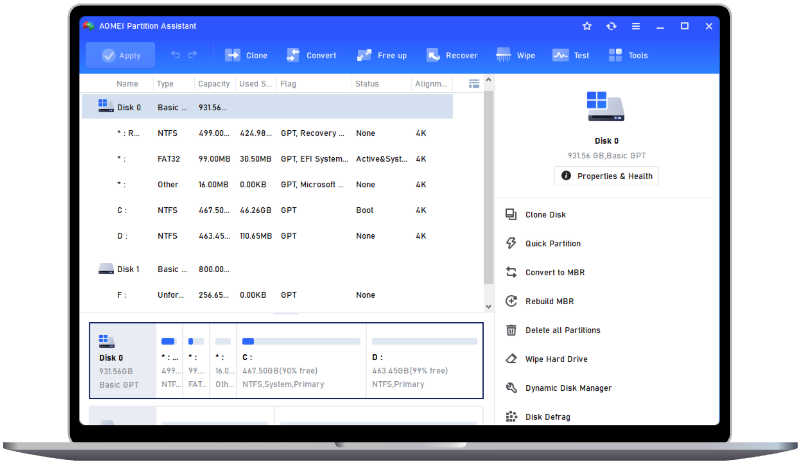What is A Memory Leak? How Do You Fix It?
In this article, you will know what is a memory leak, what causes it, and how do you fix a memory leak. With the fixes, you can effectively improve the system performance.
What is a memory leak?
RAM (Random Access Memory) is used by your computer to store data that needs to be accessed quickly, such as the operating system, programs, and services. Applications use memory to store information related to operations and frequently accessed data. When an application no longer needs a certain amount of memory, it should release it.
What causes memory leaks? Memory leaks occur when an application fails to release memory it no longer needs. This unused memory builds up over time, consuming valuable RAM and slowing down the system. In some cases, it can lead to crashes. Memory leaks are usually caused by programming errors, like forgetting to free memory or creating unnecessary references.
As RAM fills up, the operating system uses virtual memory on the hard drive or SSD as backup, which can slow down performance even further, or computer working slow. Memory leaks can also be caused by outdated drivers or software conflicts. Fixing memory leaks is essential to maintaining a smooth-running system, and in this article, we’ll show you how to identify and fix them.
How to check or detect a memory leak?
A simple way to check for a memory leak is by monitoring your system's RAM usage. If you notice that an app or process is gradually using more and more memory, it could indicate a memory leak. To detect it, you can follow the steps:
Type "Task Manager" in the search bar on your desktop. In the Processes tab, sort the Memory column to display the largest memory usage at the top. Check if the applications at the top are using an appropriate amount of memory. To close a process, right-click on it and select End task.
How do you fix a memory leak?
You can follow this section to learn how to fix a memory leak. These 6 fixes can be practical and helpful.
Method 1. Disable automatic startup of programs
Some programs automatically start when your computer boots up, using up RAM while running in the background. If you don't need these programs to launch automatically, you can disable them to free up memory.
Step 1. Type in Task Manager from the search bar at the desktop.
Step 2. Click on “Startup” in Task Manager, right-click the applications that you don’t want to run from Startup, and select “Disable”.
Method 2. Reset the Paging file size
The Paging File Size is set to be managed automatically by your system. If you adjust this setting manually, it might lead to memory compression and cause excessive memory usage. Here's how to restore the Paging File Size to its default configuration.
Step 1. Open the Windows Settings, then input "performance" and click "Adjust the appearance and performance of Windows".
Step 2. Then click "Advanced" and "Change" in turn.
Step 3. In the new window, tick "Automatically manage paging file size for all drives" and click "OK".
Step 4. In a small pop-up window, click "OK" to reset the Paging File Size.
Method 3. Defrag the disk
Fragmented files on the disk force the system to work harder to access data, increasing read/write times and indirectly affecting system efficiency.
AOMEI Partition Assistant is a powerful tool for managing your hard drive and improving its performance. Its "Disk Defrag" feature first analyzes your hard drive, allowing you to decide whether to defragment based on the analysis results. The software also saves the analysis and defragmentation status for a while, so usually, you won’t need to defragment the partition again for up to 30 days. To fix a memory leak, you can also merge partitions, cleaning your PC, check disk health with this tool.
The Best Windows Disk Partition Manager and PC Optimizer
Step 1. Install and run AOMEI Partition Assistant, right-click on the disk and select "Disk Defrag".
Step 2. Check the partition needed to be analyzed and click "Analyze". Please note you need to check the partition, not select it. Because this function currently only supports NTFS partitions, so it will only list NTFS partitions on SSD, HDD, and USB drives.
Step 3. When the analysis is complete, the program will score partition based on the fragmentation rate.
- ★There are 3 statuses according to the score:
- Normal:Score≥90. The partition is in good condition, with no need for defragmentation.
- Suggest to defragment:60≤Score<90. The current partition has some fragments, which suggest running defragmentation.
- Defragment now:Score<60. There are many fragments in the current partition, suggest running the defragmentation immediately.
You can check the distribution of fragments through the Tetris view.
Step 4. After the analysis is completed, you can click on "Details" to see more information about the analysis results:
Total files and directories Fragmented files Fragments Fragmentation Rate
Step 5. Click the "Defrag" button to start the defragmentation.
After the defragmentation is completed, the partition will be scored according to the defragmentation result.
Note: If the fragment files are in use, they cannot be defragmented.
You can set a schedule to defrag to run automatic defrag regularly. If you want to perform SSD defrag, you can click to learn the specific steps.
Method 4. Disable the System and Compressed Memory task
After setting the Paging File Size, if the System and Compressed Memory still has a high RAM usage, you can disable this process. The detailed steps are as follows:
Step 1. Press "Windows" and input "control panel", then open it. In the new window, select "Small icons" as the view method, then click "Administrative Tools".
Step 2. In the popped-out window, click "Task Scheduler".
Step 3. In the "Task Scheduler" window, click "Task Schedule Library", "Microsoft", "Windows" and "MemoryDiagnostic" in order.
Step 4. Then find out and right-click "RunFullMemoryDiagnosticEntry", then select "Disable".
Method 5. Adjust the Visual Effects for best performance
How do you fix a memory leak? You can adjust the Visual Effects for the best performance.
Step 1. Press "Win+R", then type "sysdm.cpl" and press "Enter".
Step 2. In the new window, click the "Advanced" option and "Settings".
Step 3. Tick "Adjust for best performance" and click "OK".
Step 4. Reboot the PC, seeing if the memory compression taking high memory usage issue is fixed.
To sum up
This article comprehensively introduce about the memory leaks, including what is a memory leak, what causes it, and how to fix it. A memory leak occurs when an application fails to release memory it no longer needs, leading to slow system performance or crashes. To fix a memory leak, you can monitor your system’s RAM usage, disable unnecessary startup programs, reset the paging file size, defragment your hard drive, disable certain tasks, and adjust visual effects. These steps help free up memory, improve system efficiency, and prevent further issues. Regular maintenance and monitoring are key to keeping your PC running smoothly. For Windows users who want to use the multifunctional tool to fix memory leak issue, please turn to the AOMEI Partition Assistant Server edition.


